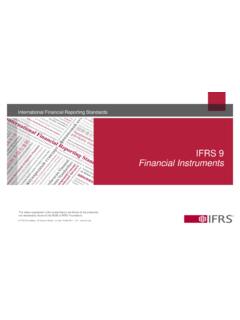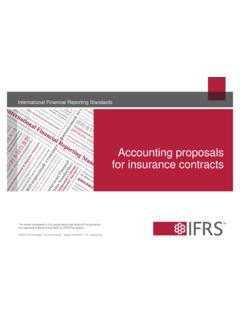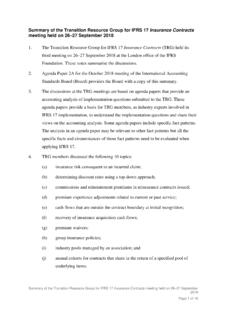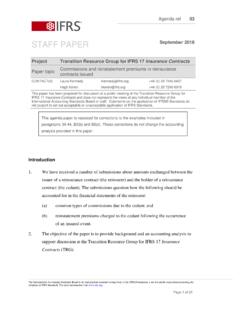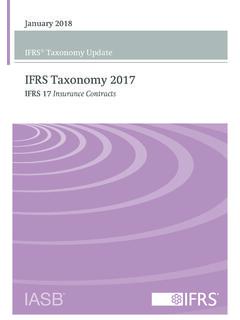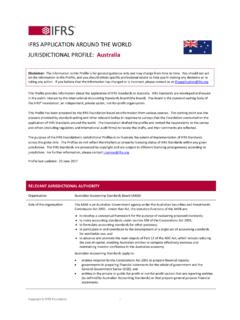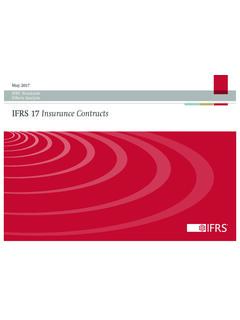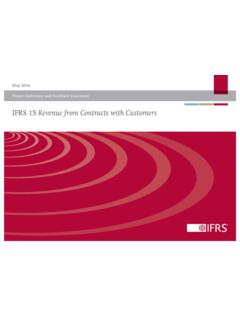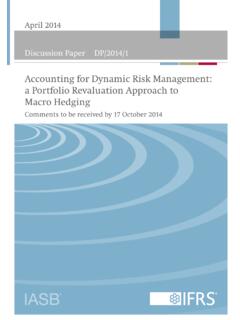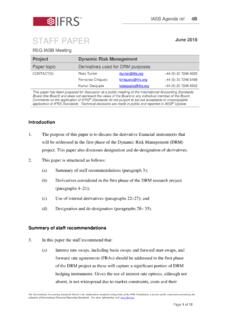Transcription of Fair Value Measurement IFRS 13
1 ifrs 13 Fair Value MeasurementIn May 2011 the international Accounting standards Board issued ifrs 13 Fair ValueMeasurement. ifrs 13 defines fair Value and replaces the requirement contained inindividual standards have made minor consequential amendments to ifrs 13. They includeIAS 19 Employee Benefits (issued June 2011), Annual Improvements to IFRSs 2011 2013 Cycle (issued December 2013), ifrs 9 financial Instruments (issued July 2014) andIFRS 16 Leases (issued January 2016). ifrs 13 ifrs FoundationA685 CONTENTS from paragraphINTERNATIONAL financial reporting STANDARD 13 FAIR Value MEASUREMENTOBJECTIVE1 SCOPE5 MEASUREMENT9 Definition of fair value9 The asset or liability11 The transaction15 Market participants22 The price24 Application to non- financial assets27 Application to liabilities and an entity s own equity instruments34 Application to financial assets and financial liabilities with offsettingpositions in market risks or counterparty credit risk48 Fair Value at initial recognition57 Valuation techniques61 Inputs to valuation techniques67 Fair Value hierarchy72 DISCLOSURE91 APPENDICESA Defined termsB Application guidanceC Effective date and transitionD Amendments to other IFRSsAPPROVAL BY THE BOARD OF ifrs 13 ISSUED IN MAY 2011 FOR THE ACCOMPANYING GUIDANCE LISTED BELOW.
2 SEE PART B OF THIS EDITIONILLUSTRATIVE EXAMPLESAPPENDIXA mendments to the guidance on other IFRSsFOR THE BASIS FOR CONCLUSIONS, SEE PART C OF THIS EDITIONBASIS FOR CONCLUSIONSAPPENDIX TO THE BASIS FOR CONCLUSIONSA mendments to the Basis for Conclusions on other IFRSsIFRS 13A686 ifrs FoundationInternational financial reporting Standard 13 Fair Value Measurement ( ifrs 13) is set outin paragraphs 1 99 and Appendices A D. All the paragraphs have equal in bold type state the main principles. Terms defined in Appendix A arein italics the first time they appear in the ifrs . Definitions of other terms are given inthe Glossary for international financial reporting standards . ifrs 13 should be read inthe context of its objective and the Basis for Conclusions, the Preface to IFRSS tandards and the Conceptual Framework for financial reporting .
3 IAS 8 Accounting Policies,Changes in Accounting Estimates and Errors provides a basis for selecting and applyingaccounting policies in the absence of explicit 13 ifrs FoundationA687 international financial reporting Standard 13 Fair Value MeasurementObjectiveThis ifrs :(a)defines fair Value ;(b)sets out in a single ifrs a framework for measuring fair Value ; and(c)requires disclosures about fair Value Value is a market-based Measurement , not an entity-specificmeasurement. For some assets and liabilities, observable market transactionsor market information might be available. For other assets and liabilities,observable market transactions and market information might not beavailable. However, the objective of a fair Value Measurement in both cases isthe same to estimate the price at which an orderly transaction to sell the assetor to transfer the liability would take place between market participants at themeasurement date under current market conditions (ie an exit price at themeasurement date from the perspective of a market participant that holds theasset or owes the liability).
4 When a price for an identical asset or liability is not observable, an entitymeasures fair Value using another valuation technique that maximises the useof relevant observable inputs and minimises the use of unobservable fair Value is a market-based Measurement , it is measured using theassumptions that market participants would use when pricing the asset orliability, including assumptions about risk. As a result, an entity s intention tohold an asset or to settle or otherwise fulfil a liability is not relevant whenmeasuring fair definition of fair Value focuses on assets and liabilities because they are aprimary subject of accounting Measurement . In addition, this ifrs shall beapplied to an entity s own equity instruments measured at fair ifrs applies when another ifrs requires or permits fair valuemeasurements or disclosures about fair Value measurements (andmeasurements, such as fair Value less costs to sell, based on fair Value ordisclosures about those measurements), except as specified in paragraphs 6and Measurement and disclosure requirements of this ifrs do not apply to thefollowing:(a)share-based payment transactions within the scope of ifrs 2 Share-based Payment;(b)leasing transactions accounted for in accordance with ifrs 16 Leases.
5 And123456 ifrs 13A688 ifrs Foundation(c)measurements that have some similarities to fair Value but are not fairvalue, such as net realisable Value in IAS 2 Inventories or Value in use inIAS 36 Impairment of disclosures required by this ifrs are not required for the following:(a)plan assets measured at fair Value in accordance with IAS 19 EmployeeBenefits;(b)retirement benefit plan investments measured at fair Value inaccordance with IAS 26 Accounting and reporting by Retirement BenefitPlans; and(c)assets for which recoverable amount is fair Value less costs of disposalin accordance with IAS fair Value Measurement framework described in this ifrs applies to bothinitial and subsequent Measurement if fair Value is required or permitted byother of fair valueThis ifrs defines fair Value as the price that would be received to sell anasset or paid to transfer a liability in an orderly transaction betweenmarket participants at the Measurement B2 describes the overall fair Value Measurement asset or liabilityA fair Value Measurement is for a particular asset or liability.
6 Therefore,when measuring fair Value an entity shall take into account thecharacteristics of the asset or liability if market participants would takethose characteristics into account when pricing the asset or liability at themeasurement date. Such characteristics include, for example, thefollowing:(a)the condition and location of the asset; and(b)restrictions, if any, on the sale or use of the effect on the Measurement arising from a particular characteristic willdiffer depending on how that characteristic would be taken into account bymarket asset or liability measured at fair Value might be either of the following:(a)a stand-alone asset or liability (eg a financial instrument or anon- financial asset); or(b)a group of assets, a group of liabilities or a group of assets andliabilities (eg a cash-generating unit or a business).
7 78910111213 ifrs 13 ifrs FoundationA689 Whether the asset or liability is a stand-alone asset or liability, a group ofassets, a group of liabilities or a group of assets and liabilities for recognitionor disclosure purposes depends on its unit of account. The unit of account forthe asset or liability shall be determined in accordance with the ifrs thatrequires or permits the fair Value Measurement , except as provided in transactionA fair Value Measurement assumes that the asset or liability is exchangedin an orderly transaction between market participants to sell the asset ortransfer the liability at the Measurement date under current fair Value Measurement assumes that the transaction to sell the asset ortransfer the liability takes place either:(a)in the principal market for the asset or liability.
8 Or(b)in the absence of a principal market, in the most advantageous marketfor the asset or entity need not undertake an exhaustive search of all possible markets toidentify the principal market or, in the absence of a principal market, themost advantageous market, but it shall take into account all information thatis reasonably available. In the absence of evidence to the contrary, the marketin which the entity would normally enter into a transaction to sell the asset orto transfer the liability is presumed to be the principal market or, in theabsence of a principal market, the most advantageous there is a principal market for the asset or liability, the fair valuemeasurement shall represent the price in that market (whether that price isdirectly observable or estimated using another valuation technique), even ifthe price in a different market is potentially more advantageous at themeasurement entity must have access to the principal (or most advantageous) market atthe Measurement date.
9 Because different entities (and businesses within thoseentities) with different activities may have access to different markets, theprincipal (or most advantageous) market for the same asset or liability mightbe different for different entities (and businesses within those entities).Therefore, the principal (or most advantageous) market (and thus, marketparticipants) shall be considered from the perspective of the entity, therebyallowing for differences between and among entities with different an entity must be able to access the market, the entity does notneed to be able to sell the particular asset or transfer the particular liability onthe Measurement date to be able to measure fair Value on the basis of theprice in that 13A690 ifrs FoundationEven when there is no observable market to provide pricing information aboutthe sale of an asset or the transfer of a liability at the Measurement date, a fairvalue Measurement shall assume that a transaction takes place at that date,considered from the perspective of a market participant that holds the asset orowes the liability.
10 That assumed transaction establishes a basis for estimatingthe price to sell the asset or to transfer the participantsAn entity shall measure the fair Value of an asset or a liability using theassumptions that market participants would use when pricing the asset orliability, assuming that market participants act in their economic developing those assumptions, an entity need not identify specific marketparticipants. Rather, the entity shall identify characteristics that distinguishmarket participants generally, considering factors specific to all the following:(a)the asset or liability;(b)the principal (or most advantageous) market for the asset or liability;and(c)market participants with whom the entity would enter into atransaction in that priceFair Value is the price that would be received to sell an asset or paid totransfer a liability in an orderly transaction in the principal (or mostadvantageous) market at the Measurement date under current marketconditions (ie an exit price) regardless of whether that price is directlyobservable or estimated using another valuation price in the principal (or most advantageous) market used to measure thefair Value of the asset or liability shall not be adjusted for transaction costs shall be accounted for in accordance with other costs are not a characteristic of an asset or a liability.
